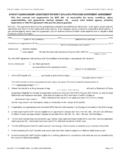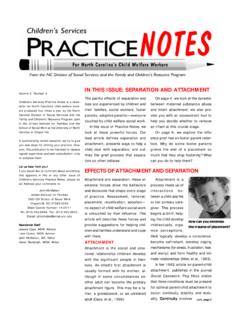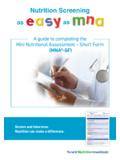Transcription of Child Session Time - icctc.org
1 Session PSYCHOEDUCATION: Understanding Trauma Topic Child Session Time Session Review Quickly review that the youth has learned and practiced several new skills. o Feeling words and how much of a feeling they are having o Ways to relax their body o How thinking-feeling are connected o We can change our thinking to feel better ( , Channel Changing). What is Trauma? Explain the meaning of the word trauma.. o The word trauma is a word we use to call scary and upsetting things that children and adults can go through. o Many children have gone through a trauma, but not all children have gone through the same types of trauma. Identify common types of traumas.
2 This discussion should be tailored specifically to meet the needs of the youth, listing general trauma types and ensuring that the Child 's trauma types are listed. o Utilize the What is Trauma? handouts to identify different types of trauma. Share that we are going to talk about different types of traumas that can happen to children. o Place the four categories of traumas on the wall, with individual traumas cut out individually and placed mixed up in a large envelope. o Invite the Child to select a trauma out of the envelope and the therapist will then briefly define the trauma. Then the Child is invited to place the trauma on the wall under the correct category heading.
3 O Descriptions that can be used for sensitive trauma types: Physical Abuse: When a parent or another adult who is taking care of a Child hurts or injures the Child 's body. It is against the law when an adult punishes a Child and the Child gets red marks, bruises, cuts, burns broken bones or hurt in another way when an adult physically abuses them. Emotional Abuse: When a parent or another adult who is taking care of a Child hurts the Child 's feelings over and over again by calling them bad names, saying bad things about the Child , or threatens to hurt the Child or others. Family violence: When one adult in a family hurts another adult in the family.
4 Hitting, biting, pushing, choking are all types of physical violence. This is also called domestic violence. It can be very scary for children to see adults hurting other adults in their home. Sexual abuse: When an adult or someone much older than a Child touches, rubs, or looks at a Child 's private parts or has the Child touch, rub or look at others' private parts. Private parts are the parts of a Child 's body that are covered by a swimsuit. The doctor's words for boy's private parts are called the penis and bottom. The doctor's words for girl's private parts are called the breasts, vagina and bottom. Sexual abuse can also include behaviors like when an adult or someone much older than the Child : Talks about private parts 2017 OUHSC Child Trauma Treatment Training Program Training materials may not be distributed without permission of the material developers.
5 Shows a Child pictures or movies about private parts Takes pictures of a Child 's private parts Makes a Child do things with their own private parts or other's private parts. Neglect: When a parent or another adult doesn't do their job to make sure that their Child has food, clean clothes, a safe home, adult supervision, or that their Child sees a doctor to stay healthy or goes to school regularly. Substance Abuse by a Family Member: When a parent another adult in the family uses too much alcohol (like beer), uses more drugs than their doctor tells them to, or uses drugs that their doctor doesn't tell them to. This can keep parents from being able to take good care of their children and keep them safe.
6 O Explain that some children may have heavy feelings about telling others about their trauma. Relaxation Break Ask the youth to identify their current feeling(s) and level on the feelings gauge. Remind the youth that they have learned different activities they can do to help lighten heavy feelings about trauma memories. Select together with the youth a brief relaxation break. Re-check the youth's current feeling(s) and level on the feelings gauge. Praise the youth's success in reducing heavy trauma-related feelings. Identifying My Trauma Remind the youth that it is never a Child 's fault when a trauma happens. State that talking about trauma to safe people can help lighten heavy thoughts and feelings.
7 Share that the next sessions will give each Child the opportunity to create their own story about their trauma memories. The therapist and Child will decide the best way for the Child to share their story and which memories to share. They will also decide on which relaxers to use to lighten any heavy feelings that may come up when telling the trauma memories. State that, in later a Session , the youth will get to share parts of their story that they want to with their caregiver(s). Their therapist will help them with this. Explain that the first step in preparing for creating their stories in the next sessions is to identify in today's Session which types of traumas the youth has experienced.
8 Ask the youth to circle on the posters each trauma type that they have experienced in their life. Provide supporting and reinforcing statements as the youth identifies their trauma types. Integrate feelings gauge checks throughout this activity and utilize relaxation breaks if the youth reports or displays heightened distress levels. What do you know about trauma Game Utilize the What Do You Know? cards to lead a game to support the youth's learning about common reactions/thoughts/feelings to trauma, common questions children may have after trauma, and other relevant psychoeducational points. Select cards specific to the trauma type(s) experienced by the youth.
9 Adjust language and question style on the cards to fit the youth's developmental level and needs. The game style may vary by developmental level, activity level, attention span, etc. of the youth. An example may include taking turns having the Child engage in a novel activity like tossing a bean bag at a target and then answering a question with help from the therapist. Reinforce and normalize common thoughts, feelings, concerns, questions. Feelings checks and relaxers should be utilized as needed to manage Child distress. 2017 OUHSC Child Trauma Treatment Training Program Training materials may not be distributed without permission of the material developers.
10 Caregiver Session Time Trauma Type Psychoeducation Today's caregiver Session time focuses on providing information on trauma. Through open discussion, we remove the stigma and shame that surrounds trauma. Throughout discussion, be listening for inaccurate or accurate, but unhelpful beliefs ( , If only Child told me, I could've stopped it. ) Provide validation/empathy for the weight of the belief and ask permission to do triangle walk-through to generate alternative thoughts. The therapist should prepare materials specific to the trauma type(s) of the Child participating in treatment. Prepare for this discussion to be brief, instead, provide caregivers with appropriate materials for education related to their Child 's trauma experience.










